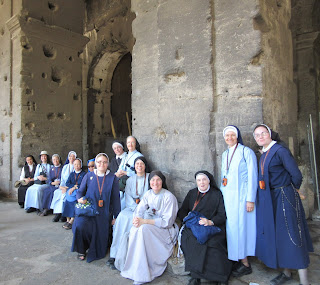 |
| Reliquary holding the forearm and hand of St. Francis Xavier. |
We headed off to where the ancient ruins have been excavated with our trusty tour guide, Sister Mary Angela, RSM.
Our first stop was the Colosseum, a massive amphitheater built by the Emperors Vespasian and Titus. The purpose of the Colosseum was purely entertainment, for rich and poor alike. Roman rulers aimed to keep their citizens well fed and well entertained so as to avoid uprisings.
The Colosseum was built in only nine years (71-80 AD), could hold 70,000 spectators and could potentially be emptied in 5 minutes due to the well-planned and extensive exits. This amazing feat of the skill of man was contrasted with the depravity of the type of entertainment. Gladiatorial contests, animal hunts and executions were common fare, with slaves, captives and Christians as the "entertainers."
 |
| Cross in above the "door of death" installed by Pope John Paul II. |
In the Jubilee year 2000, St. John Paul II had a cross installed to commemorate the martyrs who shed their blood in this contest of life. It is poignant to note that the cross is located over the "door of death," which, for these martyrs became the door of eternal life.
We next explored the Roman forum, what would today be considered "downtown" Rome. In the forum would have been bustling activity with markets, temples of gods and the Roman Senate.
We noted the immense size of all the structures, built to show honor, but also to impress visitors.
Above the Roman Forum was the Flavian Palace housing the Emperors Vespasian and Domitian. It stretched over the entire hill with extensive gardens, fountains, housing, sport and imperial business. The view from the top gives some sense of the enormity of the area. We get the name "palace" from this structure since it was located on the Palatine Hill.
 |
| Panoramic view of the Roman Forum |








No comments:
Post a Comment